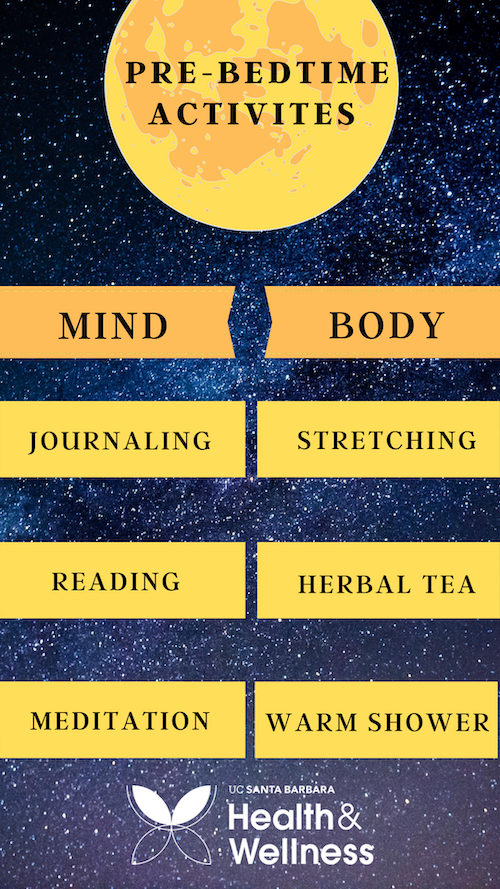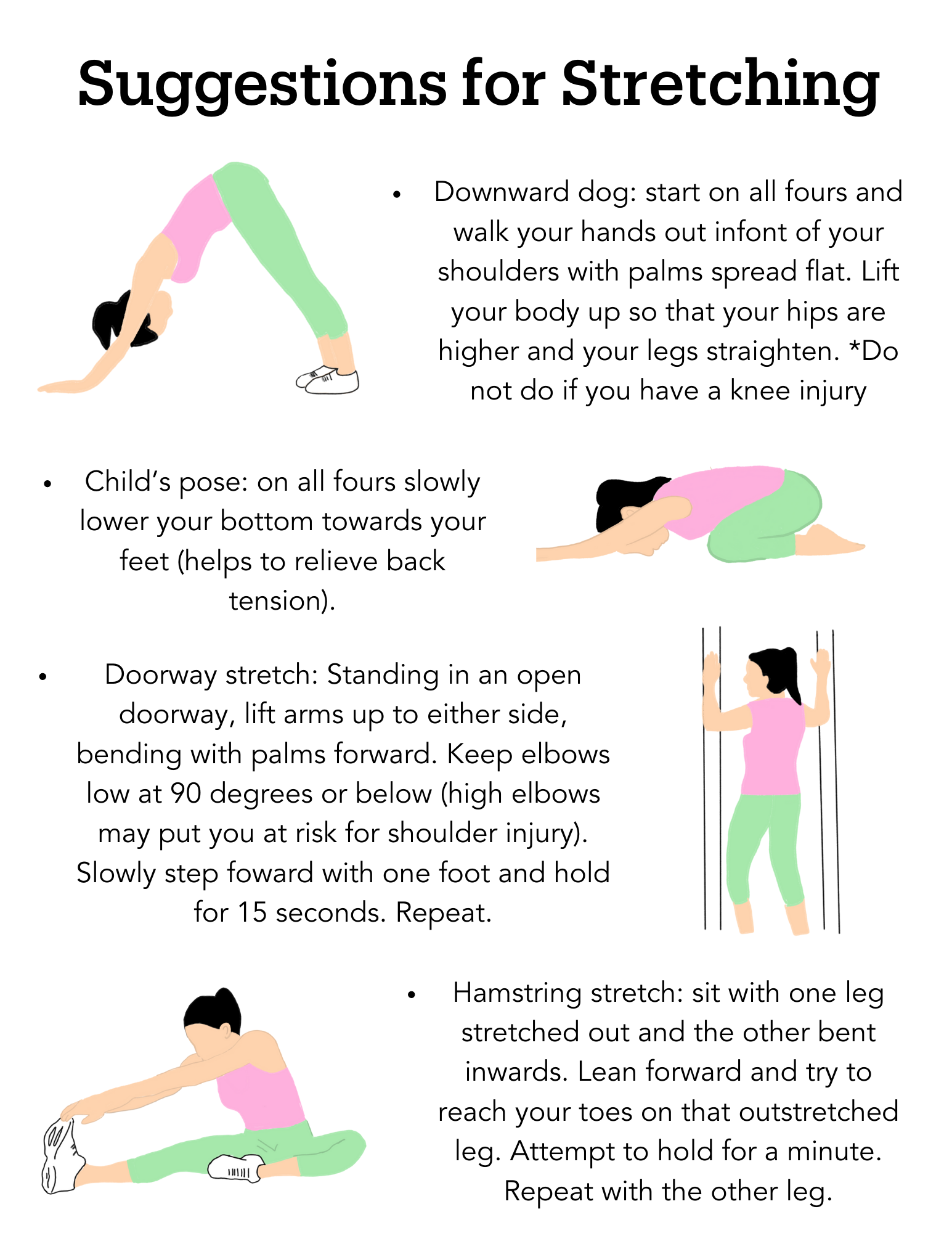
Sometimes getting to sleep can be just as hard as planning to get enough sleep. Although there are a variety of reasons why this might occur, often we have not given our minds and our bodies enough time to wind down from the busy nature of our days. The following module will outline concrete steps you can take every day to avoid those dreaded nights when you can’t seem to fall asleep.
Behavioral Routine
1. Choose a Relaxing Activity
Imagine you have a big test tomorrow that you are really nervous about. After studying all day, you look at the clock and realize it is already midnight. You decide to go to bed because you read the Memory and Learning module in the Sleep Challenge and know how important sleep is for memory. You quickly brush your teeth, put on your pajamas, and get into bed only to find yourself wide awake and unable to sleep. If this has ever happened to you, you're not alone! Physically and psychologically stressful activities like studying for a test you are anxious for can cause the body to secrete the stress hormone cortisol, which is associated with increasing alertness: the opposite state we want before bed. Thus, getting ourselves to relax both mentally and physically can help ease the transition from wake to sleep.

Mind Relaxation Activities
- Journaling: Journaling can also be a helpful tool for relaxing one’s mind before bed. Yet, a recent 2017 study showed that the type of journaling one does before bed makes a big difference in how it affects your sleep. Researchers Scullin et al. (2018) randomly assigned 57 participants ranging from 18-50 years old to either a To Do-List condition or a Completed-List condition in a lab setting. In the To-Do List condition, participants were given 5 minutes to write down all the things they needed to complete in the near future, In the Completed-List condition, participants were given 5 minutes to write down all the activities they had completed in the past few days. Thus, participants were either told to journal about past oriented or future oriented activities. Researchers then measured how long it took participants to fall asleep in the lab using a polysomnography test: a recording of bio-physiological changes. They found that participants who completed the to-do list fell asleep significantly faster than participants who journaled about their completed activities. This effect was increased when participants included more items on their to-do list. This may indicate that journaling can help quiet your mind by capturing future oriented worries and putting them away on paper. Therefore, the next time you are feeling stressed and can’t sleep before bed, try writing out a simple to-do list for 5 minutes and see how it affects your sleep!
Scullin, M. K., Krueger, M. L., Ballard, H. K., Pruett, N., & Bliwise, D. L. (2018). The effects of bedtime writing on difficulty falling asleep: A polysomnographic study comparing to-do lists and completed activity lists. Journal of Experimental Psychology: General, 147(1), 139.
- Mindfulness Meditation: This type of meditation can help us focus on the present moment and release any ruminating stressful thoughts that prevent us from relaxing before bed. To learn more about the research surrounding Meditation and Sleep, check out our Meditation module!
- Listen to Relaxing Music: It can be helpful to listen to white noise before going to sleep to mask any noise disturbances which can help you fall asleep faster according to the National Sleep Foundation. Other soothing options include rain, ocean, or forest sounds.
Pacheco, D. (2021, January 8). Bedtime Routine For Adults. National Sleep Foundation. Retrieved August 2021, from https://www.sleepfoundation.org/sleep-hygiene/bedtime-routine-for-adults

Body Relaxation Activities
- Take a warm shower or bath: The rise, then fall in body temperature can promote drowsiness.
- Eat a light snack: If you are hungry before bed, it can make it harder for you to fall asleep. Some potential bedtime snacks are: warm milk/non-caffeinated herbal tea, a small cup of low-fat yogurt with whole grain sugar-free granola, veggies with hummus, sliced apple with nut butter or whole grain seed crackers. For more information about these snacks and why they can help aid one’s sleep check out Tip #4 in our Food module!
- Try stretching, doing some light yoga, or rolling out your muscles: According to the National Sleep Foundation, stretching can help you prevent cramping before bed and relieve physical and mental tension.
Pacheco, D. (2021, January 8). Bedtime Routine For Adults. National Sleep Foundation. Retrieved August 2021, from https://www.sleepfoundation.org/sleep-hygiene/bedtime-routine-for-adults
2. Have a Consistent Sleep Schedule
Many reputable sources indicate that having a regular sleep schedule (i.e. waking up and going to bed at the same time everyday) can do wonders for your sleep (Harvard Health; National Institute of Neurological Disorder and Stroke; National Sleep Foundation). A sleep specialist may offer a variety of advice on sleep / wake cycles depending on a person’s unique situation. For example, those who suffer from clinical insomnia, it is sometimes advised to actually not go to bed until you are tired, coupled with the advice to wake up at the same time every day. However, for most sleepers, such as those seen in the study below, having a consistent sleep/wake routine can improve your relationship with sleep.
Corliss, J. (2016, September 19). Awake at 3 a.m.? Strategies to help you to get back to sleep. Harvard Health Publishing. https://www.health.harvard.edu/sleep/awake-at-3-am-strategies-to-help-you-to-get-back-to-sleep
National Institute of Neurological Disorders and Stroke. (n.d). Brain Basics: Understanding Sleep. National Institute of Neurological Disorders and Stroke. Retrieved August 2021, from https://www.ninds.nih.gov/Disorders/Patient-Caregiver-Education/Understanding-Sleep
Suni, E. (2020, September 25). Circadian Rhythm. National Sleep Foundation. Retrieved September 2021, from https://www.sleepfoundation.org/circadian-rhythm
Before we talk about consistent bedtimes, it is helpful to learn about circadian rhythms. Circadian rhythms are all the body processes that follow cyclical patterns throughout the day. For example, your body follows a cycle of wakefulness to sleepiness everyday and thus is governed by a circadian rhythm. This term comes from the Latin word “circa diem” which means “around a day.”
Your circadian rhythm is influenced by an internal clock within the hypothalamus. This clock is sensitive to external signals such as light and will release hormones related to alertness or sleepiness based on the external signals it receives. These external influences are known as zeitgebers, which is German for “time giver.”Other examples of external or environmental cues that signal to our body whether it is day or night could be physical activity, body temperature, and meal times. These zeitgebers help synchronize our circadian rhythms, which can ultimately determine when we feel sleepy and alert throughout the day.
Now, how does this relate to consistent bedtimes? Part of why consistent bedtimes are thought to be important is because they help maintain your circadian rhythm. In other words, if you sleep and wake up at the same time every day, your circadian rhythm will stay in alignment with it’s natural 24 hour cycle, and likely induce sleepiness and alertness around the proper times. Think of consistent bedtime routines as a type of zeitgebers that help you take more control of your circadian rhythms.
Can you change your circadian rhythm? Sleep Foundation. (2020, September 25). Retrieved September 2021, from https://www.sleepfoundation.org/circadian-rhythm/can-you-change-your-circadian-rhythm.
In the following study, researchers selected a sample of 39 college students with high scores of sleepiness and variable sleep schedules. Before being assigned to different conditions, the researchers instructed all participants to fill out two sleep diaries per day during a 12 day baseline period in order to gauge participants' regular sleep schedules. The sleep diaries measured daytime sleepiness, caffeine and alcohol consumption, planned naps, total napping time, bedtime, wake up time, time it took to fall asleep, number of minutes awake after having fallen asleep, number of awakenings at nights, and sleep quality.
After this initial baseline period, participants were randomly assigned into either the regularity condition or the sleep only condition and studied for 4 weeks. In the regularity condition, participants were told to go to bed and wake up at the same time everyday while also sleeping 7.5 hours every night- the bed/wake up times were selected based on the participants' baseline diary entries. In the sleep-only condition, participants were only told to sleep 7.5 hours every night. Participants in both conditions were asked to have contact with daylight and to do stimulating activities after waking up each morning as well as avoid changing their caffeine consumption. Additionally, participants continued to fill out the sleep diaries that they had at baseline. Lastly, the researchers conducted a week-long follow-up, 5 weeks after the experimental phase.
Researchers found that the regularity group has significantly lower sleepiness than the sleep only group at the end of the 4 week experiment phase and 5 weeks later during the follow up. Additionally, the regularity group took significantly less time to fall asleep and had better sleep efficiency (% of time actually asleep vs. time spent in bed) than the sleep only group at the end of the 4 week experimental phase. Thus, this thorough experiment provides compelling evidence that trying to keep a regular sleep/wake schedule that provides enough time for restful sleep, can help improve one’s relationship with sleep overall.
R. Manber, R.R. Bootzin, C. Acebo, M.A. Carskadon.The effects of regularizing sleep-wake schedules on daytime sleepiness. Sleep, 19 (1996), pp. 432-441
3. Avoid Mentally Stimulating Activities
As talked about in the Can’t Fall Asleep module, it is best to avoid stimulating activity before bed. This can include studying, scrolling social media, or having an emotionally stimulating conversation. Although writing a quick to-do list to get things off your mind is helpful for sleep, it is a good rule of thumb to also avoid complex planning, like plotting your perfect vacation, even if it feels pleasurable. (See Scullin, Krueger, Ballard, Pruett, & Bliwise’s 2018 research on to-do lists above under the header “journaling.”)
There are thousands of different ways to create a behavioral routine before bed so be sure to experiment with these different suggestions until you find one that works best for you.

This work is licensed under a Creative Commons Attribution 4.0 International License.